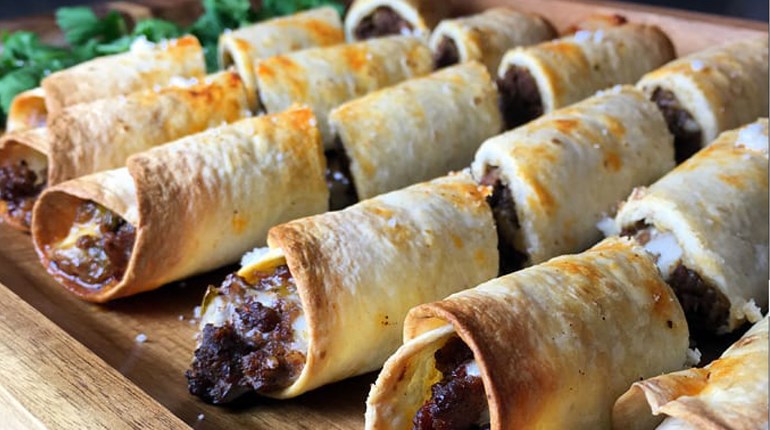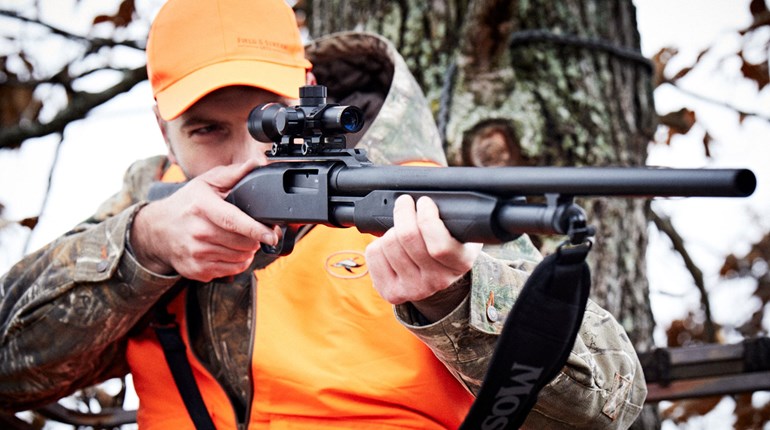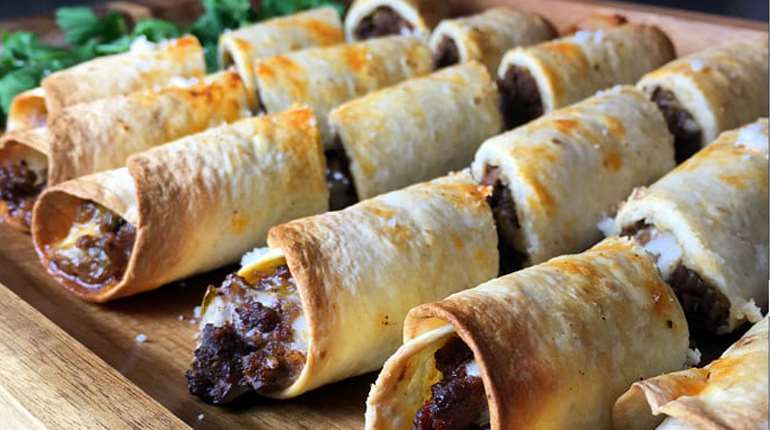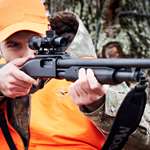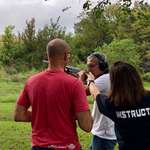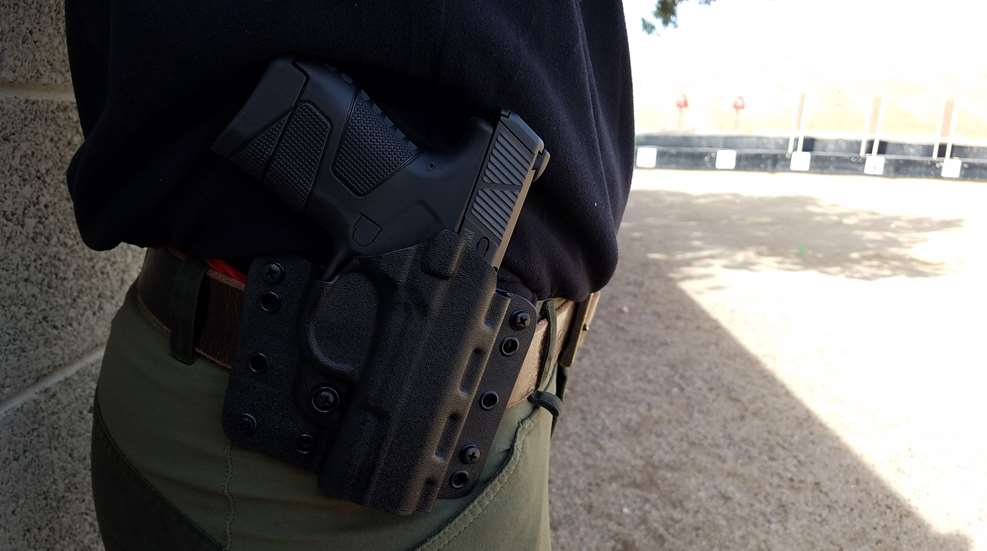
The most popular place to carry a concealed handgun on the body is on the strong side (right side if you’re right-handed, left side if you’re left-handed), usually just behind the hip. We call this the 4 o’clock position. I actually find that directly on the hip, at 3 o’clock, is the most comfortable and easiest for me to conceal, but either way, strong-side hip carry is popular for several reasons. First, it offers very fast access to the gun, because it’s riding just inches from where your hand naturally falls when your arms are hanging by your side. Second, it’s very secure and sturdy, assuming you’re wearing a proper gun belt and using a good holster. Third, it’s relatively comfortable and easy for many people to conceal a gun in this spot.
For some of us, however, strong-side hip carry just doesn’t work. Depending on your wardrobe, it can range from hard-to-hide (clingy shirts) to physically impossible (beltless dresses). If you’re having trouble making 3 or 4 o’clock work, try one of these carry positions.
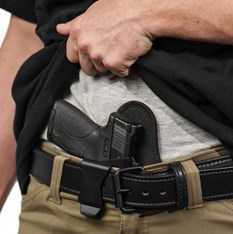
1. Appendix
Appendix carry is, basically, shoving the gun down the front of your pants, either directly under your belly button or slightly off to one side. Many people find this spot super comfortable. These people are mostly skinny, because as someone whose belly rolls over the top of my waistband when I sit, I can testify that appendix carry absolutely does not work for me when when I’m sitting down. It’s only comfortable when I stand. I also have a really hard time preaching, “Never let the muzzle cover anything you’re not willing to destroy,” and then carrying a gun that’s pointed at my own legs when I’m sitting. However, I know many very competent, respected instructors who carry this way, and it’s considered safe with a proper holster. (Image courtesy Alien Gear Holsters)
If you find it comfortable, appendix can offer very fast access to the gun, and it’s sturdy and secure. Give it a try. Your size and how low you wear your pants might limit the size of the gun you can fit in this spot.
2. Small of Back 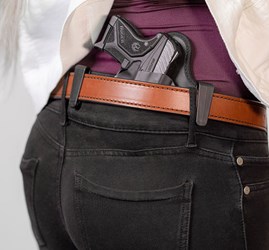
Carrying a gun on your belt so that it rests in the small of my back is extremely comfortable to me, and it’s also very easy to conceal given that I tend to wear looser-fitting tops. Those are really big pros, but this method has its cons, too.
For one thing, driving is no fun. If I were to carry small-of-back, I’d likely have to slide the holster around to one hip in order to sit back comfortably in my car. For another thing, access is slower than hip or appendix carry. You can improve your draw time with dry practice, but the one aspect of small-of-back carry you can’t fix is the danger factor. If you fall flat on your back—whether because of an innocent slip on an icy sidewalk or because an assailant shoves or wrestles you to the ground—landing on a hard gun in the small of your back can severely injure your spine. Just how big or small of a risk that is for you is something you should at least consider. (IWB holster image courtesy Tactica Defense)
3. Crossdraw High on the Ribs 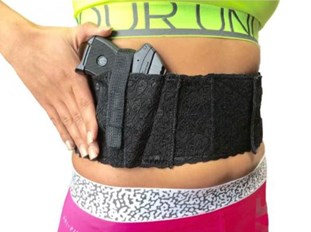
There are two ways to carry high on the ribs, basically under your armpit: In an old-school shoulder holster like you see in ’80s cop shows, in which case you’ll need to wear a jacket at all times for concealment, or in an under-the-shirt holster, most likely a belly band.
I find this carry position the easiest of all to conceal, particularly with a subcompact firearm. It also frees from from having to wear a belt (I hate belts). I carried this way for months when I first started out, but gave it up for a few reasons. One, I live in the South and belly bands get hot in the summer. Two, access is much slower than hip carry because not only did I have to lift my shirt far out of the way and reach way across an ample bosom, but I also had to almost fish the gun out of the belly band rather than just grabbing it and drawing like I can from a solid holster. It got impractical, and I don’t love the squishiness of my old belly band’s elastic—I prefer something more solid covering the trigger—so I gave it up, but I keep the belly band around for that rare outfit where I just can’t wear a belt or carry a gun on my hip. (Belly band photo courtesy of DalTechForce)
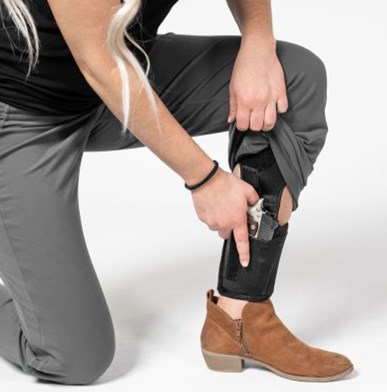
4. Ankle
I’ve never tried an ankle holster, but I know a woman who carries a subcompact .380 in a small holster specially designed to clip onto her cowboy boot. It works for her. There are also ankle holsters that don’t require a boot but are held up by hook-and-loop or elastic bands. I have my doubts about the comfort of these, but if you’re attending an event where you’ll be wearing beltless wide-leg dress pants or a floor-length gown, an ankle holster might be a viable option.
An obvious downside to ankle carry is access—your gun is pretty far away from your hands, and there’s no guarantee you’ll be able to crouch or bend if you’re engaged in a conflict. This is enough to make it a deal-breaker for me except maybe in very specialized, rare circumstances. I also have to imagine that it’s pretty limiting to your wardrobe. Skinny jeans need not apply! (Ankle holster photo courtesy of Tactica Defense)
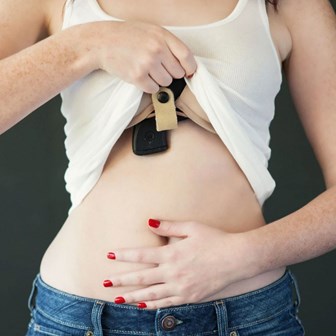
5. Bra
Yep, they make a holster that dangles a gun from your bra, keeping it secure against your ribcage, right in front. The original model is called the Flashbang, and many women swear by it. Obviously, the size of the gun is limited, but I can see how a gun carried in this position would be easy to conceal, especially for the more well-endowed among us.
I don’t love how this holster leaves you walking around with a gun pointed at the whole world, but it does have a solid trigger-guard cover that won’t allow the trigger to be accidentally pulled. It would take some draw practice, but access could be relatively quick, assuming you’re not wearing a dress or a tucked-in shirt. (Flashbang bra photo courtesy of Flashbang)
In Summary
Today, various manufacturers are making all sorts of clothing with built-in holsters that let you carry in many of the above-mentioned places, and more. You can even buy tactical tank tops and leggings with built-in holsters or pockets for a holster. If the athleisure look is your jam, these might be great options for you.
Whatever carry position you choose, it’s important that you utilize a proper holster made for that kind of carry. Do not just stick a gun in your waistband, your pocket or your purse without a holster that keeps the gun securely in position with the trigger guard covered.
It’s also important that you practice drawing an unloaded gun from your chosen carry position. This is important for any concealed carrier, but doubly so if you’ve chosen one of the less traditional positions that make access to the gun a little slower. Practice with real-world clothing that you actually wear, including shirts tucked and untucked, slim-fit and looser tops, dresses and skirts if you wear them, and jackets or coats. You want to find out you can’t reach your small-of-back firearm when you’re wearing your heavy winter coat at home, in practice—not on the street in a life-or-death situation.
Lastly, pick one carry position and stick with it for the most part. Take your time experimenting to find what works for you, but the goal is to eventually settle into one that works in most circumstances and then reserve other positions and holsters for those rare specialty situations. You don’t want to carry in a different spot every day and waste time remembering “where’s my gun today?” when you need to draw it in an emergency.













